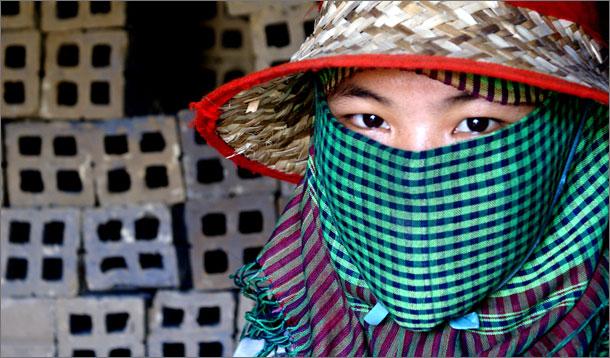
The colourful scarves in the image above may look cheerful, but their purpose is chilling: to protect children’s lungs from the choking dust of the brick factory. This Cambodian girl works from sunrise to sunset, stacking bricks on piles 20 feet high.
I’m usually the first mom on our street ready for back-to-school. I’m known for kamikaze trips to kids’ clothing stores en route from work to home. Even on vacation, I’m back in my seat from the outlet mall before my husband has filled the gas tank.
But this year, the process has been much more thoughtful. Once or twice, I’ve actually stopped cold in the store entrance. It’s like I’m standing frozen in another doorway—a hotel that I visited with World Vision in May. I had travelled to Cambodia to learn all I could about boys and girls who are forced to work, in preparation for our End Child Slavery campaign.
I had just spent the day at a brick factory. I’d met children who work as slaves so travelers like me can sleep in sturdy hotels. The factory was like an oven, even before we got near the furnace. But the children had been near—brutally near. The burns on their skin told the story. So did the grinding, shrieking, brick-making machine that just the week before had chewed a girl’s arm off.
Later, in my brick hotel, I made my first-ever direct connection between the money in my wallet and real boys and girls. If I paid to stay here, would I have blood on my own hands?
Back in Canada, with the benefit of distance, I have the option of forgetting what I saw. But I find that I can’t. An estimated 126 million children worldwide do 3D jobs—work that is dirty, dangerous and degrading. These jobs include work in cocoa plantations, cotton fields and garment factories.
I owe it to the boys and girls in that Cambodian factory to remember the power I have as a consumer. With back-to-school shopping on the agenda, I’ve started looking at clothing labels. I want to do right by my own sons, too. It doesn’t seem fair to dress them in “deals” without gently helping them understand why the prices are low.
I’ve come up with a few strategies:
![]() I research the children’s clothing companies I support through websites that look at labour standards:
I research the children’s clothing companies I support through websites that look at labour standards:
![]() I buy second-hand. This guarantees that I’m not directly contributing to child slavery.
I buy second-hand. This guarantees that I’m not directly contributing to child slavery.
![]() I support FairTrade companies. Who knew that 10,000 Villages has fantastic pencil cases?
I support FairTrade companies. Who knew that 10,000 Villages has fantastic pencil cases?
![]() I’m doing World Vision’s Shopping for Change activities with my boys, helping them to think about their power as consumers.
I’m doing World Vision’s Shopping for Change activities with my boys, helping them to think about their power as consumers.
Back-to-school shopping this year has taken on a whole new feel. It may not be quick, and I may not be getting the best deals. But I feel that in clothing my own kids, I’m also honouring others.

Deb Wolfe with children from the brick factory who come to a World Vision centre in Cambodia to rest, learn and play.

